Magnetic-Measuring Square in the Measurement of the Circular Curve of Rail Transport Tracks
Abstract
1. Introduction
- Surveying pins prisms (adapter pin) for mounting various surveying prisms (Figure 1b);
- A surveying pin (adapter pin) with a guide for mounting a surveying target (disc) with an extended graduation;
- Reference signals for laser scanning (Figure 1c,d);
- A rolled up meter;
- Specialised measuring strings;
- Horizontal and vertical measuring target (disk) (Figure 5a,c);
- Measuring archet (Figure 2a,b), measuring archet adapter.
- Measurements of geometrical parameters of tracks and turnouts railways;
- Measurements of the horizontal and vertical versines;
- Checking the measurement of rails shortenings and perpendicularity of rail joint;
- Measurements of creeping of the rail (displacement continuous welded rail (CWR));
- The track zeroing measurements;
- Intertrack space measurements;
- Measuring the infrastructure gauge (structure gauge);
- Measurement of second differences (gradients) in the height of turnouts or diamond crossings;
- Levelling tracks and tornouts railways.
- Versine measurements: the MMS was used in the operation mode with a taut measuring line (string) and laser distance meter (laser rangefinder) with a laser beam;
- Rail shortenings and the perpendicularity of rail joints: the MMS was applied in the operation mode with a laser distance meter with a laser beam and a horizontal surveying measuring disk.
- km 14,860–14,980: entry transitional curve P1 = 120 m;
- km 14,980–15,640: full railway track curve R = 1090 m, L = 660 m;
- km 15,640–15,760: exit transitional curve P2 = 120 m.
2. Methods of Measurement Using the MMS
2.1. Versine Measurement
- Two rail measuring squares (left and right) with a pin with a guide, an edge plate, a taut measuring line, and a measuring archet in a horizontal plane (chord base length ci = 10 m);
- One measuring square with the cap of a laser distance measuring device, the cap installation pin, the stabilizer bracket, the laser distance measuring device (laser beam: class II; laser power P < 1 mW; laser wavelength λ = 635 nm), the edge plate, and the measuring archet, with an archet adapter providing vertical orientation (chord base length ci = 10 m) (Figure 2).
2.2. Measurement of Rails Shortenings and the Perpendicularity of Rail Joints
- the perpendicularity of rail joints to the track axis,
- the perpendicularity of opposite rail joints, and
- rail shortenings.
- A measuring square with a cap of a laser distance measuring device, cap installation pin, stabilizer bracket, and laser distance measuring device with or without an edge plate (Figure 5a,b,d);
- A measuring square with a horizontal surveying measuring disk (equipped with amillimeter scale and concentric rings) with or without an edge plate (Figure 5a,c,d) or with a surveying pin (adapter pin) with a guide for mounting a surveying target (disc) with an extended graduation.
- Regular rails within the external rails, and
- Shortened rails within the internal rails.
3. Results
3.1. Analysis and Evaluation of the Results of Versine Measurements Obtained from the MMS
3.2. Analysis and Evaluation of the Results of the Measurement of Rails Shortenings Obtained from the MMS
- The calculated length is ;
- The shortening of the internal rails is ;
- The assumed rail shortening is 45 mm;
- The whole calculated length requires 1.073/0.045 = 23.8 ≈ 25 shortened rails;
- The assumed length of a regular rail is l = 30 m;
- The relation of shortened to regular rails is .
- Seria A: 42; 45; 45; 46; 47 mm;
- Seria B: 44; 46; 46; 45; 44 mm.
4. Discussion
- 5 m for radius R < 250 m;
- 10 m for radius from R = 250 m to R < 800 m;
- 20 m for radius from R = 800 m to R < 2000 m;
- 25 m for radius from R = 2000 m to R < 4000 m;
- 50 m for radius R ≥ 4000 m.
5. Conclusions
6. Patents
Funding
Acknowledgments
Conflicts of Interest
References
- Checking the Versine Survey Precision. 2016. Available online: https://pwayblog.com/2016/12/27/checking-the-versine-measurement-precision/ (accessed on 8 May 2018).
- Kędra, Z. Technologia Robót Torowych; Wydawnictwo Politechniki Gdańskiej: Gdańsk, Poland, 2015. [Google Scholar]
- Allgemeines zum Horizontalen Trassenverlauf. Available online: https://www.gleisbau-welt.de/lexikon/gleisbau-und-instandhaltung/gleisvermessung/pfeilhoehenmessung/ (accessed on 8 May 2018).
- Chainage Creep. 2016. Available online: https://pwayblog.com/2016/10/06/chainage-creep/ (accessed on 8 May 2018).
- Track Realignment and Rectification. 2016. Available online: https://pwayblog.com/2016/12/05/track-realignment-and-rectification/ (accessed on 9 May 2018).
- Chen, Q.; Niu, X.; Zuo, L.; Zhang, T.; Xiao, F.; Liu, Y.; Liu, J. A railway track geometry measuring trolley system based on aided INS. Sensors 2018, 18, 538. [Google Scholar] [CrossRef]
- Sánchez, A.; Bravo, J.L.; González, A. Estimating the accuracy of track-surveying trolley measurements for railway maintenance planning. J. Surv. Eng. ASCE 2017, 143, 05016008. [Google Scholar] [CrossRef]
- Glaus, R. Kinematic Track Surveying by Means of a Multi-Sensor Platform. Ph.D. Thesis, ETH, Zürich, Switzerland, 2006. [Google Scholar]
- Marx, L.; Moβmann, D.; Kullmann, H. Arbeitsverfahren für Die Instandhaltung des Oberbaus; Eisenbahn-Fachverlag: Heidelberg, Germany, 2003. [Google Scholar]
- Naganuma, Y.; Yada, T. Development of truly portable track geometry recording trolley and accompanying new measurement principle. In Proceedings of the 15th International Conference on Railway Engineering Design and Operation (CR 2016), Madrid, Spain, 19–21 July 2016. [Google Scholar]
- Technical Conditions for Maintaining Track Surface on Railway Lines Id-1 (D-1). 2015. Available online: https://www.plk-sa.pl/files/public/user_upload/pdf/Akty_prawne_i_przepisy/Instrukcje/Wydruk/Warunki_techniczne_Id-1_ujednolic.pdf (accessed on 19 September 2019).
- Kamiyama, M.; Yoshimura, A.; Furukawa, A.; Mori, T. Software for Railway Track Irregularity Correction Using Heavy Tamping Machine. WIT Trans. Built Environ. 1998, 37, 10. [Google Scholar]
- Oshimura, A. A New Method for Repairing Railway Track Irregularities Using Levelling and Lining Machines. WIT Trans. Built Environ. 1996, 20, 10. [Google Scholar]
- Chiou, S.B.; Yen, J.Y. Precise railway alignment measurements of the horizontal circular curves and the vertical parabolic curves using the chord method. Proc. Inst. Mech. Eng. F J. Rail. Rapid Transit 2018, 233, 537–549. [Google Scholar] [CrossRef]
- Wang, P.; Wang, Y.; Tang, H.; Gao, M.; Chen, R.; Xu, J. Error theory of chord-based measurement system regarding track geometry and improvement by high frequency sampling. Measurement 2018, 115, 204–216. [Google Scholar] [CrossRef]
- Yazawa, E.; Takeshita, K. Development of Measurement Device of Track Irregularity using Inertial Mid-chord Offset Method. Q. Rep. RTRI 2002, 43, 125–130. [Google Scholar] [CrossRef]
- Zhang, Z.B.; Qing, L.; Wang, H.R.; Shen, Y. An Algorithm for the Curve Versine Measurements on Railway Tracks. Adv. Mat. Res. 2014, 43, 1955–1960. [Google Scholar] [CrossRef]
- Weston, P.; Roberts, C.; Yeo, G. Stewart, E. Perspectives on railway track geometry condition monitoring from in-service railway vehicles. Veh. Syst. Dyn. 2015, 53, 1063–1091. [Google Scholar] [CrossRef]
- Westeon, P.F.; Ling, C.S.; Roberts, C.; Goodman, C.J.; Li, P.; Goodall, R.M. Monitoring vertical track irregularity from in-service railway vehicles. Proc. Inst. Mech. Eng. F J. Rail. Rapid Transit 2007, 221, 75–88. [Google Scholar] [CrossRef]
- Weston, P.F.; Ling, C.S.; Goodman, C.J.; Roberts, C.; Li, P.; Goodall, R.M. Monitoring lateral track irregularity from in-service railway vehicles. Proc. Inst. Mech. Eng. F J. Rail. Rapid Transit 2007, 221, 89–100. [Google Scholar] [CrossRef]
- Andani, M.T.; Peterson, A.; Munoz, J.; Ahmadian, M. Railway track irregularity and curvature estimation using doppler LIDAR fiber optics. Proc. Inst. Mech. Eng. F J. Rail. Rapid Transit 2018, 232, 63–72. [Google Scholar] [CrossRef]
- Maciuk, K. Advantages of combined GNSS processing involving a limited number of visible satellites. Sci. J. Silesian Univ. Technol. Ser. Transp. 2018, 98, 89–100. [Google Scholar] [CrossRef]
- Maciuk, K. GPS-only, GLONASS-only and combined GPS+GLONASS absolute positioning under different sky view conditions. Teh. Vjesn. 2018, 25, 933–939. [Google Scholar]
- Al-Douri, Y.K.; Tretten, P.; Karim, R. Improvement of railway performance: A study of Swedish railway infrastructure. J. Mod. Transp. 2016, 24, 22–37. [Google Scholar] [CrossRef]
- Chiacchiari, L.; Loprencipe, G. Measurement methods and analysis tools for rail irregularities: A case study for urban tram track. J. Mod. Transp. 2015, 23, 137–147. [Google Scholar] [CrossRef]
- Kampczyk, A. Magnetic-Measuring Square and Its Application. Patent Application P.420214, 16 January 2017. [Google Scholar]
- Kampczyk, A. Adapter for Assembling Reference Signals to Scanners. Utility Model PL 69951 Y1, 10 February 2016. [Google Scholar]
- Technical Standard “About Organization and Execution of Measurements in Railway Surveying” GK-1, Warsaw. 2015. Available online: https://www.pkp.pl/images/geodezja/dokumenty/Standard%20techniczny%20%E2%80%9EO%20organizacji%20i%20wykonywaniu%20pomiar%C3%B3w%20w%20geodezji%20kolejowej%E2%80%9D%20GK-1.pdf (accessed on 14 September 2019).
- Kampczyk, A. Pomiar strzałek montażowych toru zwrotnego w rozjeździe. Przegląd Geodezyjny 2017, 89, 4–9. [Google Scholar] [CrossRef]
- Kampczyk, A. Pomiar geometrycznych warunków widoczności przejazdu kolejowo-drogowego. Przegląd Komunikacyjny 2017, 72, 2–7. [Google Scholar]
- Kampczyk, A. Measurement innovations in railway infrastructure safety. World Sci. News 2017, 89, 336–347. [Google Scholar]
- Zamięcki, H. Budowa i utrzymanie dróg kolejowych; Wydawnictwo Komunikacji i Łączności: Warszawa, Poland, 1978. [Google Scholar]
- Technical Rules for the Maintenance and Operation of the Track Surface on Public Service Railway Lines D1. 1982. Available online: http://kolej.krb.com.pl/d1/zal11.htm (accessed on 21 September 2019).
- Regulation of the Minister of Transport and Maritime Economy of 10 September 1998 on Technical Conditions to Be Met by Railway Structures and Their Location. Available online: http://prawo.sejm.gov.pl/isap.nsf/DocDetails.xsp?id=WDU19981510987 (accessed on 21 September 2019).
- Zhang, Q.; Chen, Q.; Niu, X.; Shi, C. Requirement assessment of the relative spatial accuracy of a motion-constrained GNSS/INS in shortwave track irregularity measurement. Sensors 2019, 19, 5296. [Google Scholar] [CrossRef]
- Instruction for Measuring, Researching and Assessing Track Condition Id-14 (D-75). 2010. Available online: https://www.plk-sa.pl/files/public/user_upload/pdf/Akty_prawne_i_przepisy/Instrukcje/Podglad/Id-14.pdf (accessed on 22 September 2019).
- Bryś, H.; Jaśkowski, W.; Gołuch, P. Autonomiczny system wyznaczania geometrii deformacji długich szyn prowadnic wind - telemonitoring wyzwaniem geodezji XXI wieku. Przegląd Geodezyjny 2017, 89, 3–6. [Google Scholar] [CrossRef]
- Bryś, H.; Ćmielewski, K. Niwelacyjny system pomiarowy z zastosowaniem laserowej stopki sygnalizacyjnej. Przegląd Geodezyjny 2019, 91, 19–21. [Google Scholar] [CrossRef]


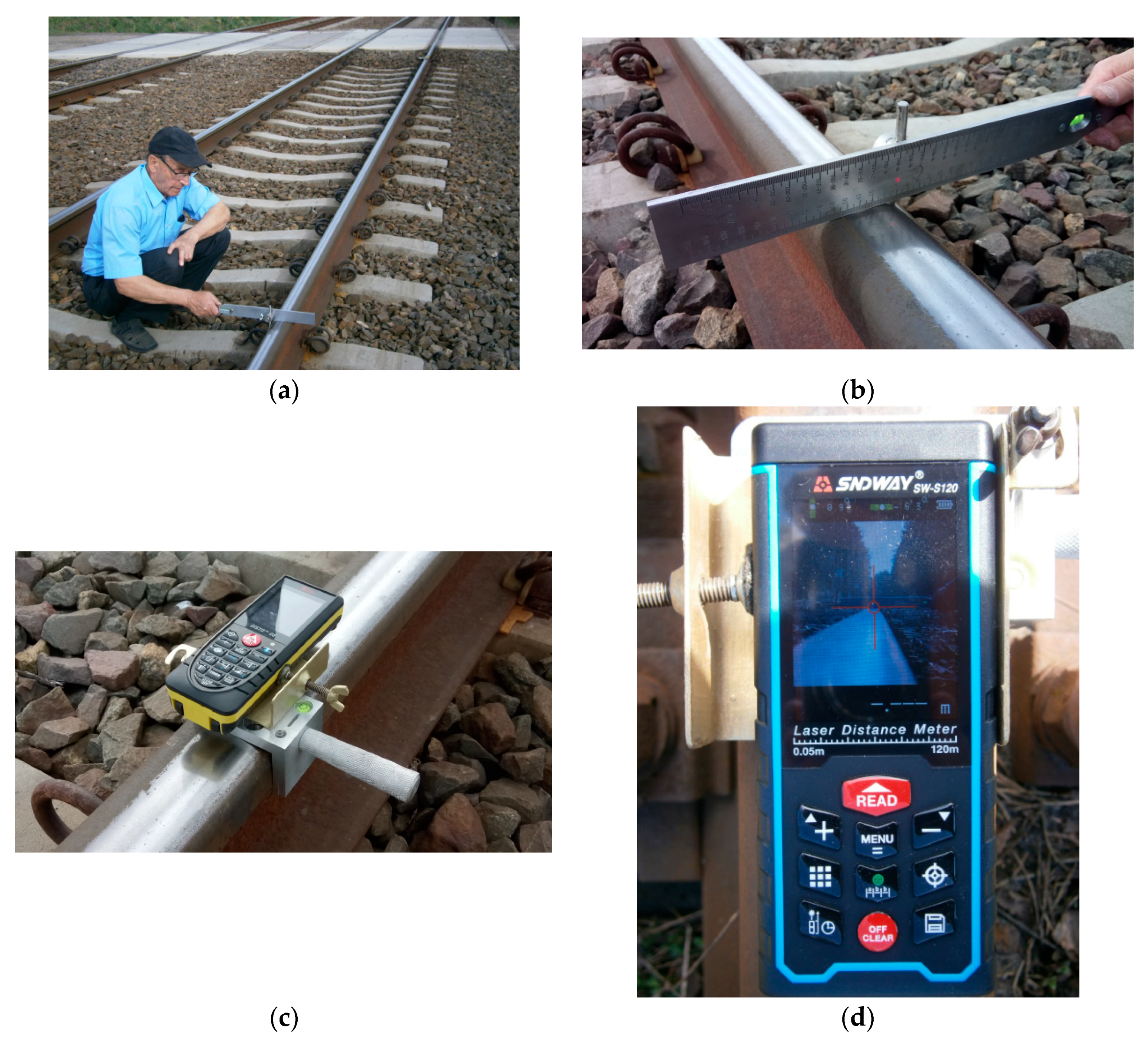

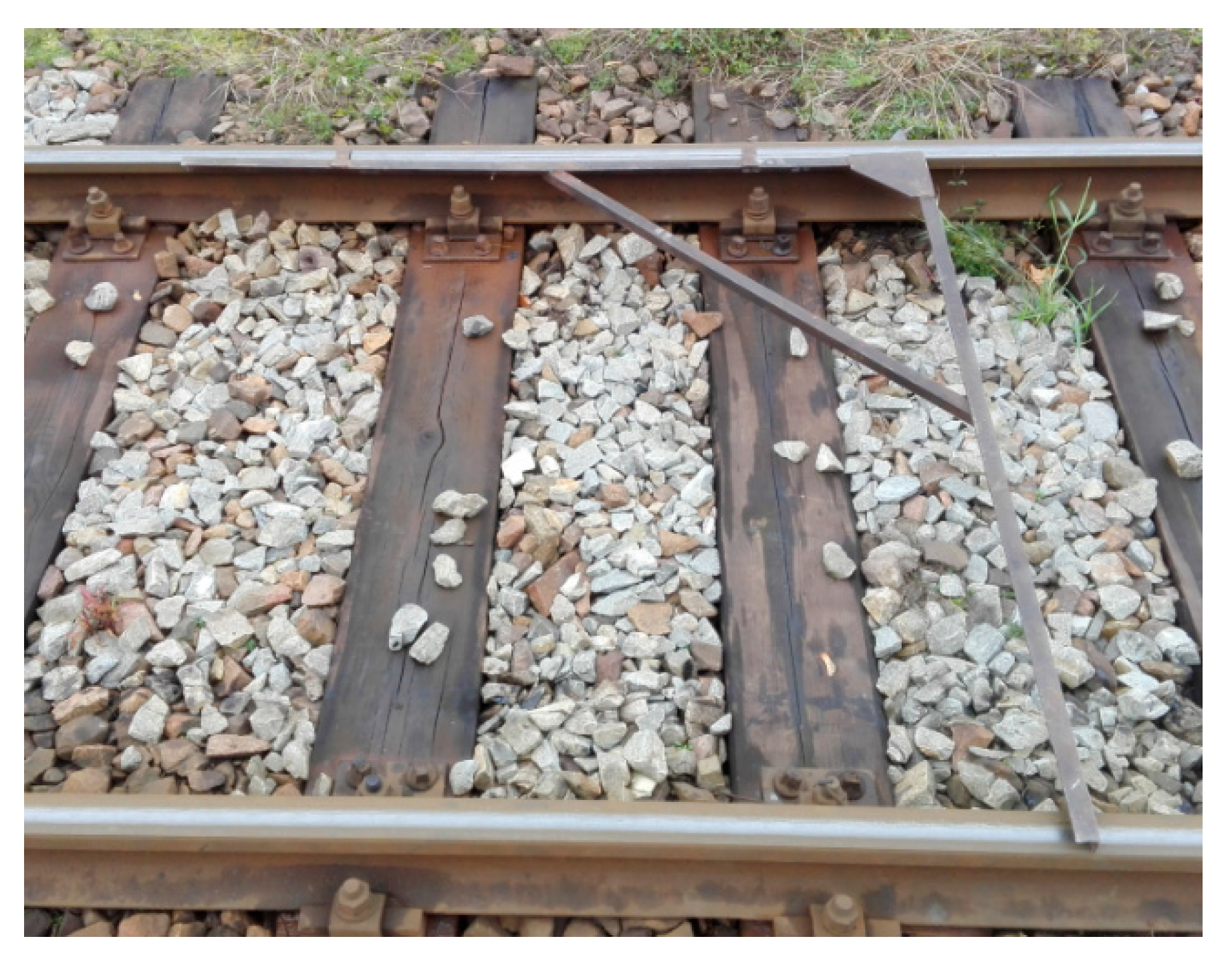

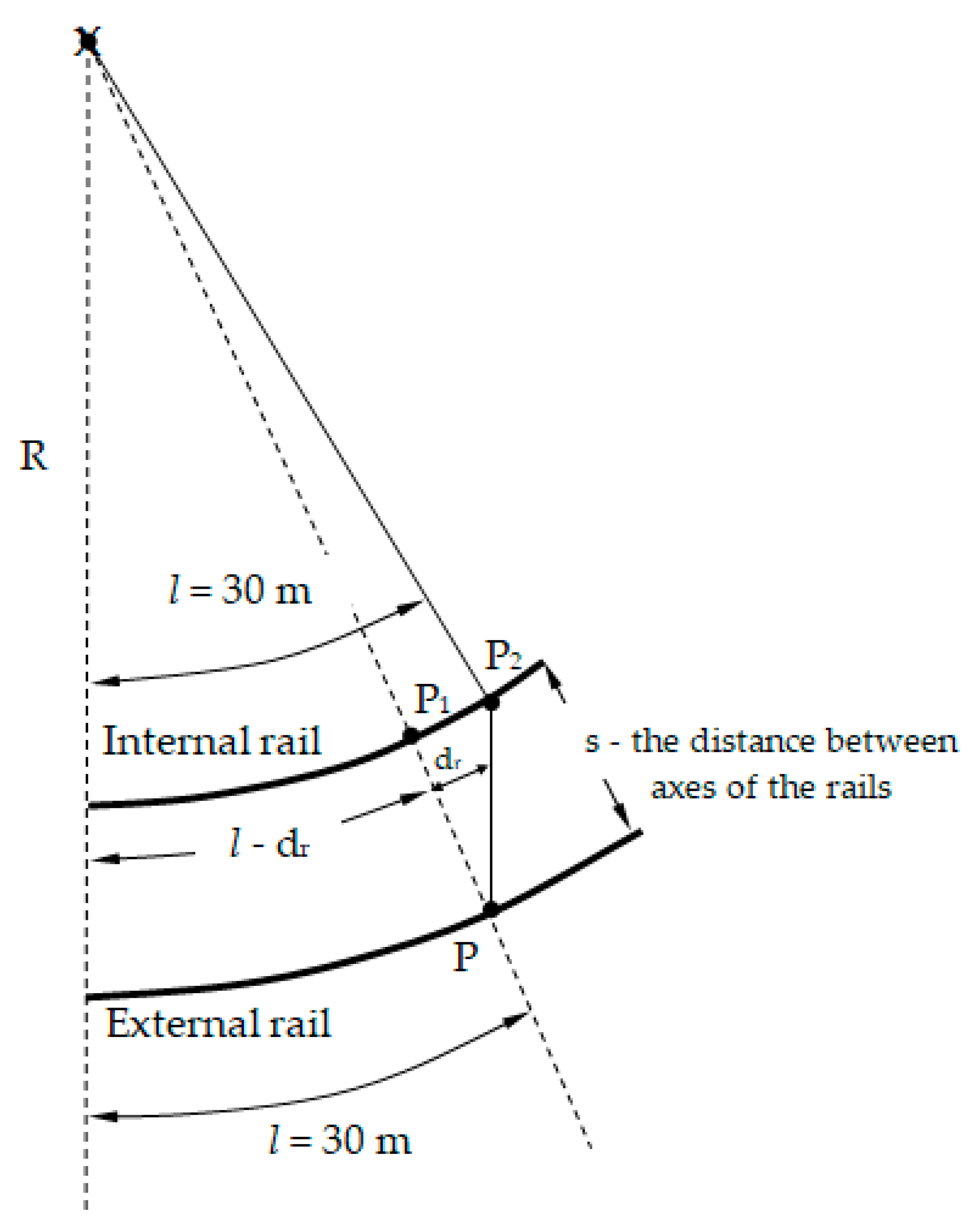
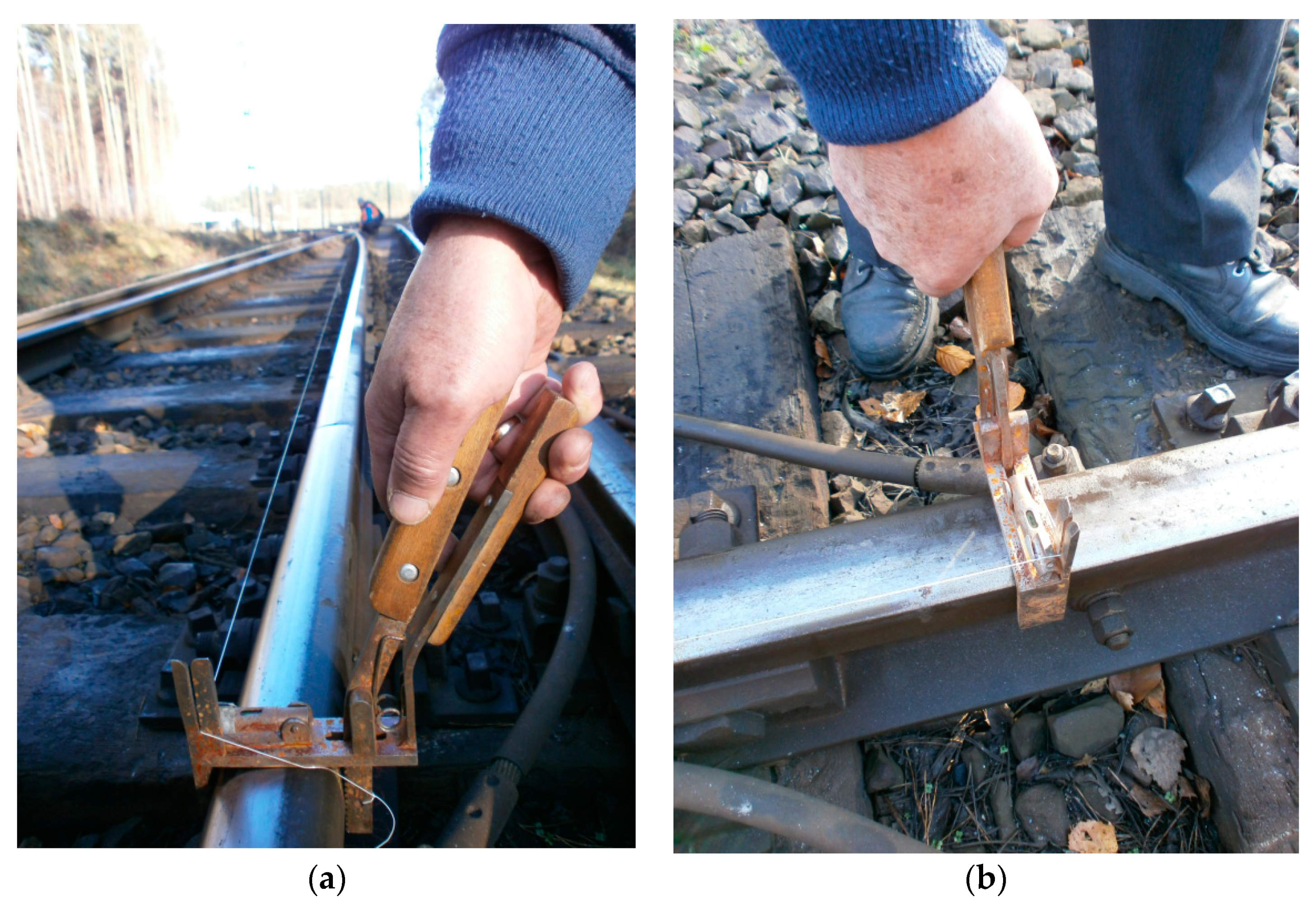
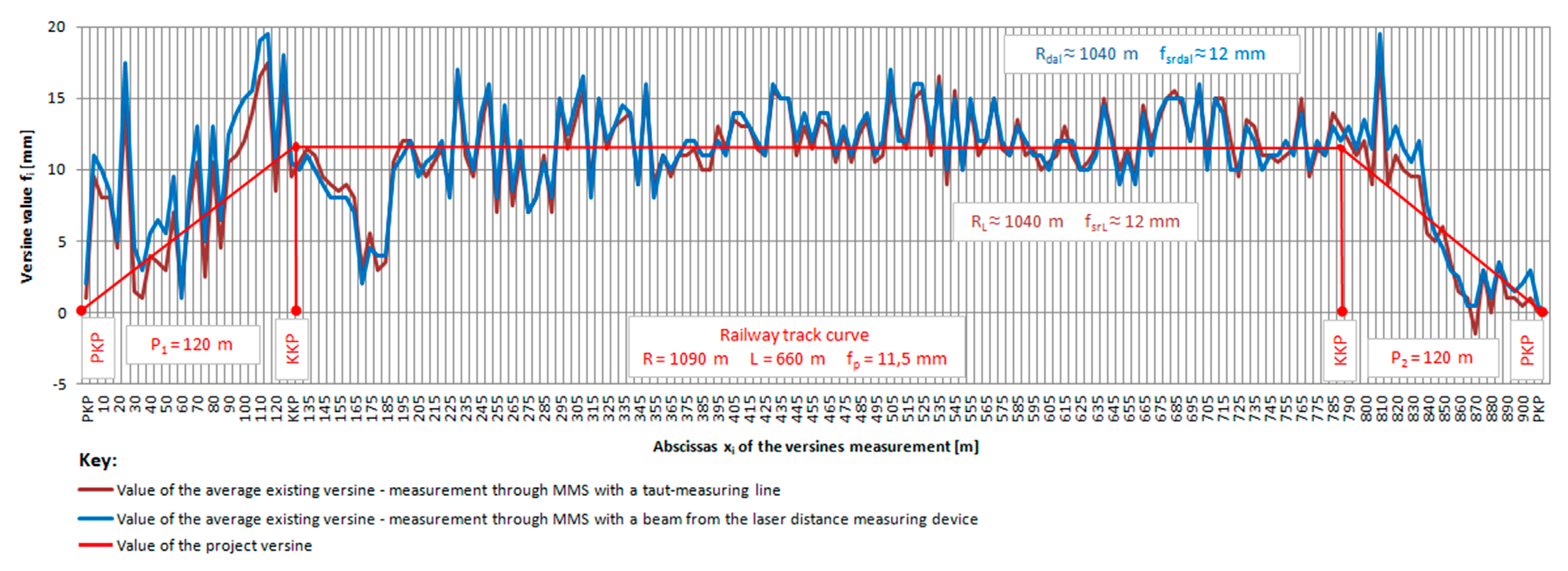
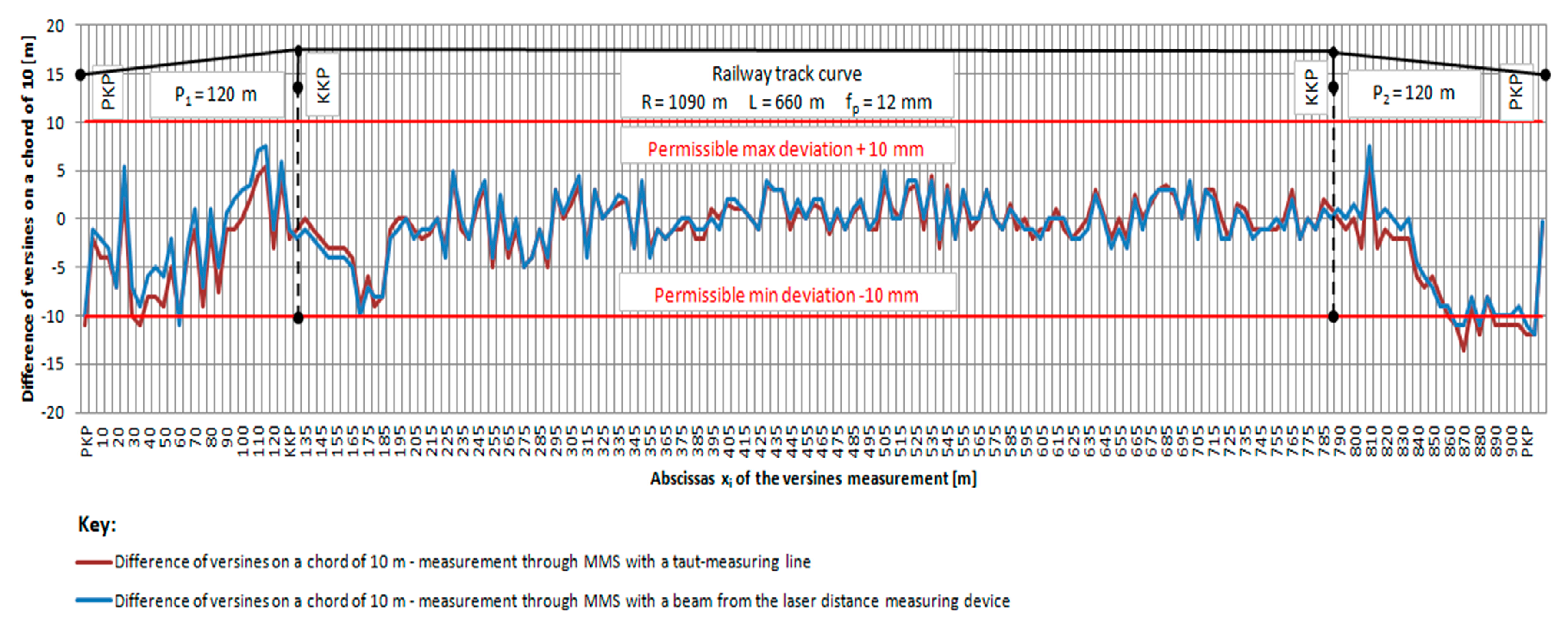
© 2020 by the author. Licensee MDPI, Basel, Switzerland. This article is an open access article distributed under the terms and conditions of the Creative Commons Attribution (CC BY) license (http://creativecommons.org/licenses/by/4.0/).
Share and Cite
Kampczyk, A. Magnetic-Measuring Square in the Measurement of the Circular Curve of Rail Transport Tracks. Sensors 2020, 20, 560. https://doi.org/10.3390/s20020560
Kampczyk A. Magnetic-Measuring Square in the Measurement of the Circular Curve of Rail Transport Tracks. Sensors. 2020; 20(2):560. https://doi.org/10.3390/s20020560
Chicago/Turabian StyleKampczyk, Arkadiusz. 2020. "Magnetic-Measuring Square in the Measurement of the Circular Curve of Rail Transport Tracks" Sensors 20, no. 2: 560. https://doi.org/10.3390/s20020560
APA StyleKampczyk, A. (2020). Magnetic-Measuring Square in the Measurement of the Circular Curve of Rail Transport Tracks. Sensors, 20(2), 560. https://doi.org/10.3390/s20020560




